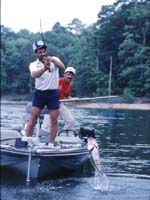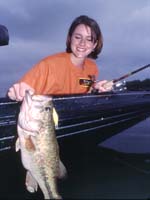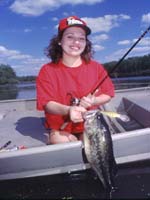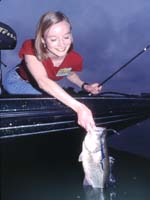
|
Features
|
|
|
|
Books
|
|
|
|
Fun & Games
|
|
|
|
Contact Us
|
|
|
John's Journal... Entry 45, Day 5
Opt for the Best Plan
 EDITOR'S
NOTE: To have a fishing hole that consistently will produce 8-pound bass
or bigger, you'll have to do your homework. To pinpoint and fish these
types of ponds, have a friend who's already intensively managing his pond.
Or, manage your own farm pond carefully. But to have a big-bass fishing
pond to fish, rent, lease, borrow or obtain permission from the landowner
for you to help pay for the maintenance needed to build your dream pond.
EDITOR'S
NOTE: To have a fishing hole that consistently will produce 8-pound bass
or bigger, you'll have to do your homework. To pinpoint and fish these
types of ponds, have a friend who's already intensively managing his pond.
Or, manage your own farm pond carefully. But to have a big-bass fishing
pond to fish, rent, lease, borrow or obtain permission from the landowner
for you to help pay for the maintenance needed to build your dream pond.
To catch big bass in a pond with too many bass, you usually have to remove large numbers of those little bass.
"One of the biggest problems with this management technique is getting the landowner to agree to someone's taking large numbers of small bass out of his lake," Don Keller, a fisheries biologist and one of the owners of American Sportfish, a fish hatchery in Montgomery, Alabama, emphasized. "For years, fishermen have been told to catch and release bass. However, if you do release those small bass, you're actually hurting, not helping a pond."
 Pond
owners can limit what size bass anglers catch out of a pond in several
ways. They can decide to take all the bass 14 inches or less or set up
a slot limit to take the bass 14 inches or less and those 18 inches or
more. But since small bass generally represent the biggest problem for
the overcrowded pond, anglers need to take a large number of those little
bass out quickly. Keller further states that if you have a 20-acre pond
full of stunted bass, you may have to take out as much as 25 pounds of
bass per acre in a short time, probably within two to three months.
Pond
owners can limit what size bass anglers catch out of a pond in several
ways. They can decide to take all the bass 14 inches or less or set up
a slot limit to take the bass 14 inches or less and those 18 inches or
more. But since small bass generally represent the biggest problem for
the overcrowded pond, anglers need to take a large number of those little
bass out quickly. Keller further states that if you have a 20-acre pond
full of stunted bass, you may have to take out as much as 25 pounds of
bass per acre in a short time, probably within two to three months.
"If you multiply 25 pounds of bass per acre by 20 acres, you'll realize you'll have to remove 500 pounds of bass from that pond," Keller explained. "Now if the majority of bass in that pond weigh about 1/2-pound each or less, you must take 1000 or more bass out of that 20-acre pond to remove 500 pounds of bass.
"When a landowner sees 1000 bass weighing less than a pound each coming out of his pond, he automatically thinks that every bass in the pond has been caught. He'll probably doubt that his pond will ever produce bass again. That one factor is the reason most landowners won't allow sport fishermen to catch the number of bass required to get the pond to the point where it can produce big bass."
 Keller
suggests as an alternative that the pond owner hire a private, small-pond
consultant to come in with an electro-fishing boat, determine the number
of bass that need to come out of the pond and take those bass from the
pond in one day using electro-fishing tactics.
Keller
suggests as an alternative that the pond owner hire a private, small-pond
consultant to come in with an electro-fishing boat, determine the number
of bass that need to come out of the pond and take those bass from the
pond in one day using electro-fishing tactics.
"If you try to take that 500 pounds of bass out of that 20-acre lake over a year, you really won't have any impact on the lake," Keller reported. "As fast as you're taking those 1000, 1/2-pound bass out of the lake, small bass are replacing them. You must harvest a large number fast to eliminate that replacement factor.
"The best time to harvest the small bass is prior to the spawn. By taking the small bass out before they have a chance to spawn, you can actually reduce the number of bass in the lake, thereby letting the bluegills spawn successfully, which will provide more food for the bass that are left."
Deer hunters have learned that to have trophy bucks on their lands they generally must reduce the number of animals on their property. In many regions of the country, they have to harvest large numbers of unantlered deer. This same principle applies to small ponds with too many bass.
 Once
you've transformed your pond from a stunted, overcrowded bass pond into
a quality trophy-bass pond, then record keeping becomes the key ingredient
to continue to produce large numbers of big bass in that pond.
Once
you've transformed your pond from a stunted, overcrowded bass pond into
a quality trophy-bass pond, then record keeping becomes the key ingredient
to continue to produce large numbers of big bass in that pond.
"You have to keep up with the pounds of bass you're harvesting each year if you want your pond to keep on producing the size of bass you want to catch," Keller said. "A simple system that works very effectively is to have a mailbox and a hanging scale located right beside your pond. Keep a logbook in the mailbox to record each day the weight and numbers of the bass and bluegill coming out of the pond."
To learn more about growing big bass, send a self-addressed, stamped envelope to American Sportfish, % Don Keller, PO Drawer 20050, Montgomery, AL 36120 to get a special free report, "Secrets to Small-Pond Management."
Check back each day this week for more about How To Raise Big Bass ...
Day 1 -Quick-Fix
Day 2 -Eat Skillet-Sized Bass from Your Pond
Day 3 -Make a Small-Bass Pond a Big-Bass
Pond
Day 4 -Feed the Bluegills
Day 5 -Opt for the Best Plan